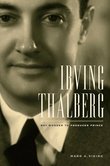Mark A. Vieira,
Irving Thalberg: Boy Wonder to Producer Prince
Berkeley, University of California Press, 2010
ISBN: 9780520260481
US$34.95 (hb)
528pp
(Review copy supplied by University of California Press)
Irving Grant Thalberg was born in Brooklyn, New York, in 1899 with a congenital heart condition that would kill him 37 years later. By the time of his death he had become one of the most important and influential figures in Hollywood. Perhaps more than any other, it was Thalberg who provided the template for the movie-mogul archetype of the pop culture imagination: authoritarian, regal and ruthlessly efficient. As Mark A. Vieira notes, when Thalberg fired director Erich von Stroheim from Merry-Go-Round (USA 1923), it was a David and Goliath battle—with the producer, not the director, in the David role. It was Thalberg who made American film a producers’ medium for its Golden Age.
By the age of 21 Thalberg was executive in charge of production at Universal. Upon leaving in 1924, he teamed up with Louis B. Mayer to become one of the founders of MGM and one of the most powerful figures in Hollywood, famous for his insistence on re-writes and re-writes, re-shoots and re-shoots. The pressure he put on those in his employ to achieve perfection occasioned some enmity, but often admiration and loyalty.
Pressure is a key theme in Vieira’s book. Not only the pressure Thalberg placed on his staff, but also the pressure he placed on himself and the external pressures he had to contend with. Vieira does an expert contextualisation job, detailing the stresses caused by the coming of sound, the Great Depression, the Hays Code, unionisation in Hollywood and the increasingly uncooperative Mayer. Further pressure came from newspaper magnate William Randolph Hearst demanding prestigious starring roles for his lover Marion Davies, fascists in Europe threatening to boycott MGM product, Chiang Kai-sheck keeping a watchful eye by proxy on how Nationalist China would be portrayed in The Good Earth (USA 1937), and even the Pacific Ocean—whose lapping waves proved so distracting to Thalberg that he had his beach house soundproofed. Viera presents all these obstacles under the ever-present shadow of Thalberg’s defective heart.
During Thalberg’s reign at MGM, there were some who simply were not suited to coping with the pressures of a top-down, systemic production arrangement. Buster Keaton saw his autonomy as a creator and performer compromised to an unbearable degree, his desperate situation compounded by the fact that the films he despised—Parlour, Bedroom and Bath (USA 1931) and Sidewalks of New York (USA 1931)—were profitable, leaving him little room to negotiate. Writers also often found themselves unfairly treated, with multiple contributors engaged in multiple re-writes, only to see the screen credit be awarded to a star name. Vieira’s analysis does not shy away from engaging with the brutality of the system, but he does stress that Thalberg recognised that the various talents that combined to make a film were more than mere commodities.
Vieira demonstrates great skill in his deployment of revealing anecdotes, admirably resisting the temptation to impose his authorial voice with unnecessary exposition, allowing his research to speak for itself. One example sees Morrie Ryskind who, having conducted one of the umpteenth re-writes for the Marx Brothers’ first MGM picture, A Night at the Opera (USA, 1935), watched in dismay as an apparently unimpressed Thalberg studied his latest gags. On completing his inspection, a stone-faced Thalberg handed the script back to Ryskind saying, “Morrie, this must be some of the funniest stuff I’ve ever read.” Vieira’s book is agreeably punctuated with gobbets such as this, which help flesh out an enigmatic figure who approached his role as entertainment provider with deep seriousness.
Vieira’s voice is most apparent when highlighting Thalberg’s achievements and examining the complexity of his output. For Vieira, Thalberg’s production of popular films does not mean that they were compromised artistically, and he points to films such as The Crowd (USA 1928) and White Shadows in the South Seas (USA 1928) as evidence of Thalberg’s willingness to take risks, and faith in his audience. He also emphasises Thalberg’s role as an advocate of cinema as an art form, citing his repeated questioning of contemporary cultural prejudice against the movies and his pioneering role in the field of film preservation.
Vieira’s work is both exhaustively researched and beautifully presented, rich in detail yet compulsively readable. If you want to know about Hollywood’s Golden Age, then you must know about Thalberg. And if you want to know about Thalberg, then you must read this book. Vieira’s impeccable scholarship has resulted in an intricate portrait of one of Hollywood’s most inscrutable figures; a mercurial mogul navigating and moulding Hollywood through the turbulence of the 1920s and 30s, during the course of a life he knew would be truncated.

